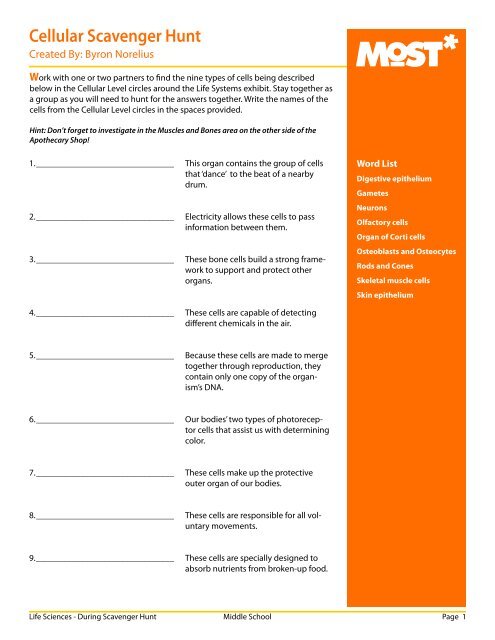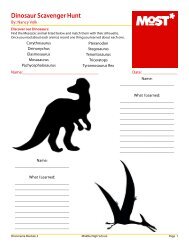Cellular Scavenger Hunt Answer Key
Cellular Scavenger Hunt Answer Key
Cellular Scavenger Hunt Answer Key
Create successful ePaper yourself
Turn your PDF publications into a flip-book with our unique Google optimized e-Paper software.
<strong>Cellular</strong> <strong>Scavenger</strong> <strong>Hunt</strong><br />
Created By: Byron Norelius<br />
Work with one or two partners to find the nine types of cells being described<br />
below in the <strong>Cellular</strong> Level circles around the Life Systems exhibit. Stay together as<br />
a group as you will need to hunt for the answers together. Write the names of the<br />
cells from the <strong>Cellular</strong> Level circles in the spaces provided.<br />
Hint: Don’t forget to investigate in the Muscles and Bones area on the other side of the<br />
Apothecary Shop!<br />
1. _______________________________<br />
2. _______________________________<br />
3. _______________________________<br />
4. _______________________________<br />
5. _______________________________<br />
6. _______________________________<br />
7. _______________________________<br />
8. _______________________________<br />
9. _______________________________<br />
This organ contains the group of cells<br />
that ‘dance’ to the beat of a nearby<br />
drum.<br />
Electricity allows these cells to pass<br />
information between them.<br />
These bone cells build a strong framework<br />
to support and protect other<br />
organs.<br />
These cells are capable of detecting<br />
different chemicals in the air.<br />
Because these cells are made to merge<br />
together through reproduction, they<br />
contain only one copy of the organism’s<br />
DNA.<br />
Our bodies’ two types of photoreceptor<br />
cells that assist us with determining<br />
color.<br />
These cells make up the protective<br />
outer organ of our bodies.<br />
These cells are responsible for all voluntary<br />
movements.<br />
These cells are specially designed to<br />
absorb nutrients from broken-up food.<br />
Word List<br />
Digestive epithelium<br />
Gametes<br />
Neurons<br />
Olfactory cells<br />
Organ of Corti cells<br />
Osteoblasts and Osteocytes<br />
Rods and Cones<br />
Skeletal muscle cells<br />
Skin epithelium<br />
Life Sciences - During <strong>Scavenger</strong> <strong>Hunt</strong> Middle School Page 1
<strong>Cellular</strong> <strong>Scavenger</strong> <strong>Hunt</strong> <strong>Answer</strong> <strong>Key</strong><br />
Organ of Corti cells<br />
1. _______________________________<br />
Neurons<br />
2. _______________________________<br />
Osteoblasts and Osteocytes<br />
3. _______________________________<br />
Olfactory cells<br />
4. _______________________________<br />
Gametes<br />
5. _______________________________<br />
Rods and Cones<br />
6. _______________________________<br />
Skin epithelium<br />
7. _______________________________<br />
Skeletal muscle cells<br />
8. _______________________________<br />
Digestive epithelium<br />
9. _______________________________<br />
New York State Standards<br />
Middle School<br />
Standard 4: <strong>Key</strong> Idea 1; <strong>Key</strong> Idea 5<br />
This organ contains the group of cells<br />
that ‘dance’ to the beat of a nearby<br />
drum.<br />
Electricity allows these cells to pass<br />
information between them.<br />
These bone cells build a strong framework<br />
to support and protect other<br />
organs.<br />
These cells are capable of detecting<br />
different chemicals in the air.<br />
Because these cells are made to merge<br />
together through reproduction, they<br />
contain only one copy of the organism’s<br />
DNA.<br />
Our bodies’ two types of photoreceptor<br />
cells that assist us with determining<br />
color.<br />
These cells make up the protective<br />
outer organ of our bodies.<br />
These cells are responsible for all voluntary<br />
movements.<br />
These cells are specially designed to<br />
absorb nutrients from broken-up food.<br />
Life Sciences - During <strong>Scavenger</strong> <strong>Hunt</strong> Middle School Page 2










